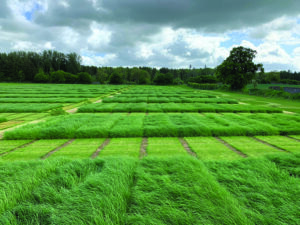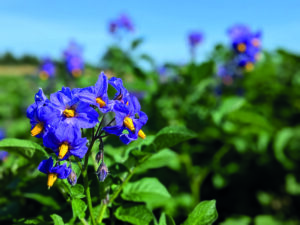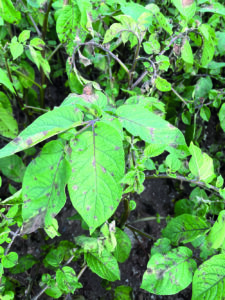Crops, forestry & plants
Real-time forage quality for smarter breeding

Credit: Teagasc
Dan Milbourne, Stephen Byrne, Agnieszka Konkolewska, Rachel Keirse, Helena Hennessey
Improving forage digestibility is vital for enhancing animal performance in pasture-based livestock systems. However, traditional methods for assessing forage quality are labour-intensive and limit forage breeding progress. New tools are needed to enable rapid, cost-effective, and scalable measurement of nutritive value throughout multi-year breeding programmes.
Predictive models were developed to accurately estimate forage digestibility in real-time, using harvester-mounted Near-Infrared Reflectance Spectroscopy (NIRS) on fresh samples. This overcomes key limitations of conventional laboratory-based NIRS, which relies on dried, milled samples and is too labour-intensive for large-scale breeding trials. The new approach enables rapid, real-time analysis of dry matter digestibility across thousands of plots during routine harvesting. With good predictive accuracy, this system allows for high-throughput, season-long forage quality monitoring of the breeding programme, accelerating genetic improvement of forage cultivars.
The NIRS system and developed calibrations are now on the Teagasc forage breeding programme’s harvester – enabling routine, high-throughput measurement of digestibility at scale, without additional labour. This enables the capture of more complete and detailed data across the growing season, supporting more informed selection decisions and accelerating genetic gain for forage quality. This enhances the capacity of breeders to develop high-performing, climate-resilient forage cultivars for Ireland’s livestock farmers.
Contact: dan.milbourne@teagasc.ie
Other contributors: University College Dublin
Funding: Research Ireland; Department of Agriculture, Food and Marine; European Union Horizon 2020
Impact Pathway: Capacity Building
An IPM metric for Irish horticulture

Credit: Teagasc
Lael Walsh, Fiona Thorne, Jennifer Byrne
Adopting sustainable agriculture and promoting farm-level ecology incorporates Integrated Pest Management (IPM) by farmers.
The measurement and adoption of IPM has remained a challenge in the Irish horticulture sector because of diverse crops and systems of production. Over 2023 and 2024, the AgSustain project developed a horticulture IPM metric, using over 30 growers and advisors in three Delphi-method workshops for the top fruit, field, and protected crop systems in food horticulture. This metric was trialled and tested with 100 Irish growers to evaluate their IPM adoption.
This information was combined and analysed to develop and publish a unique IPM metric for food horticulture, the first of its kind, to measure and compare IPM across systems of production. Results of the survey show adoption is widespread among Irish growers with scores in the low- to mid-range (under 70, out of a maximum 100) with field crop growers performing best. This IPM metric has more recently been applied to a larger multi-country dataset of 480 farms to understand its application beyond Ireland, with a view to refining best practice. Cross-country comparison shows Ireland lags behind England in IPM adoption, with the policy landscape being highly influential on adoption at farm-level. The metric provides a method to benchmark IPM performance and chart cumulative progress on a national and cross-national basis, and highlights areas for improvement.
Contact: lael.walsh@teagasc.ie
Other contributors: University of Warwick; University of the Highlands and Islands
Funding: Teagasc Walsh Scholars Programme
Impact Pathways: Technology Development & Adoption; Policy Influencing
Controlling fungicide resistance to late blight

Credit: Teagasc
Steven Kildea, Amanpreet Kaur, Deirdre Doyle, Ewen Mullins, Shay Phelan
In late autumn 2023, a single sample of Phytophthora infestans with resistance to the carboxylic acid amide group of fungicides was detected in Ireland. Currently the control of potato late blight caused by P. infestans is almost exclusively reliant on the application of fungicides. This highlights the immediate and significant threat the detection of this strain posed to the Irish potato industry.
To prevent such devastating impacts, it is essential to be able to rapidly detect this strain, devise control strategies to prevent its spread, and effectively communicate this to the industry.
A coordinated approach was taken between crops researchers and specialists to develop detection tools, and devise and disseminate field control strategies. To detect resistance, the team developed a digital droplet PCR capable of detecting P. infestans and associated fungicide resistance in a variety of matrices including potato leaves, FTA® preservation cards and spore samples. This allowed for the rapid and extremely sensitive detection of resistance.
In parallel, control strategies were devised which ensured both the mixing and alternation of fungicides at each application, guaranteeing field control whilst limiting potential selection for the resistant strain. These strategies were communicated to the industry throughout the season via dedicated workshops, crop walks, press articles and a trials tour. Whilst the strain was again detected in 2024, its impact on late blight control has been contained.
Contact: stephen.kildea@teagasc.ie
Funding: Teagasc core funding
Impact Pathway: Technology Development & Adoption
